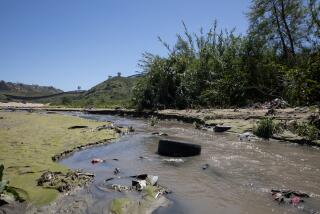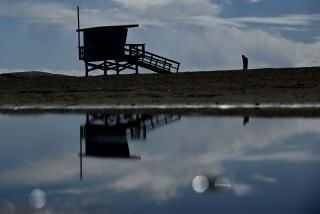Bacteria Level Dips in Spills Along Coast : Sewage: The return to legal bacterial levels may prompt county health authorities to lift the quarantine of 20 miles of coastline.
Toxic bacterial counts, fed by ongoing sewage spills, dipped dramatically here Wednesday, prompting county health authorities to say they may lift the 20-mile quarantine of area coastline as early as Friday morning.
Ruth Covill, a spokeswoman for the San Diego County Department of Health Services, said that, for the first time since the rupture of a massive sewage outfall pipe Feb. 2, readings fell below the legal limit, except at the tip of the Point Loma Peninsula.
Health authorities want to wait until Friday to assess the situation, Covill said, fearing a blustery storm today may send readings from the international border to the San Diego River âsoaring sky-high once again.â
San Diegoâs spill, which continues to send 180 million gallons a day of partially treated sewage spewing into the sea 3,150 feet from the cliffs off Point Loma, at a depth of 35 feet, has combined with an overflow of raw sewage from Tijuana to create crisis ocean conditions.
Twenty miles of coastline, extending from the mouth of the Tijuana River to the neighborhood of Ocean Beach, have been closed since the first week of February. Covill said that even optimistic readings Friday may fall short of lifting the ban entirely.
She said 4 1/2 miles of coastline, extending from the tip of Point Loma northward to Ladera Street, at the western edge of Sunset Cliffs Park, will âundoubtedly remain closed,â pending the completion of $10 million in repairs to the huge outfall pipe.
Those efforts continued Wednesday, with divers surveying and photographing more sections of the 30-ton pipe. Twenty-two sections are damaged less than three-quarters of a mile offshore, and late Monday divers discovered further damage at the 5,800-foot mark.
Ordinarily, the pipe discharges the effluent--from which 75% to 80% of the solids have been removed--2.2 miles at sea, at a depth of 220 feet. Officials said Tuesday severed joints near the one-mile mark were causing the pipe to leak effluent at a depth of 55 feet and may have influenced the larger rupture.
Deputy City Manager Roger Frauenfelder said Wednesday that 250 feet of the outfall pipe bear âscrapeâ marks near the one-mile mark, leading some to speculate that a passing ship could have damaged the pipe, which had not ruptured since being installed in 1963.
âWe have not come to any further conclusion regarding the cause of the scrapes,â Frauenfelder said. âItâs tough to imagine how a craft could have moved that, but we want to be thorough.
âWeâll investigate any thought anybody has; we donât want to leave any possibility unturned. I donât think itâs likely that a ship caused the scrapes, but at the same time, I canât explain them.â
City officials continue to maintain that ânatural, externalâ forces, such as settlement on the ocean floor, combined with heavy wave action during a period of recent low tides, triggered the break in the pipe, which is nine feet in diameter and 11,000 feet long.
Workers at the Point Loma treatment facility told The Times last week that exercising a diversion gate and throttling valve at the same time created a massive âwater hammerâ that led to the break in the pipe--an account local officials have vigorously disputed.
âPersonally, I think wave action played a role here in the progressive failure of the pipe,â Frauenfelder said. âThe breakup of 500 feet of pipe must have been associated with strong surf and the type of forces such wave action could muster.â
The Regional Water Quality Control Board has called for an independent forensic expert to conduct a full investigation of the breakdown in the pipe, which has refocused debate about San Diegoâs methods of waste disposal. The outfall pipe alone serves 1.7 million residents.
Frauenfelder said continued good weather may reopen a binational pump station that under drier conditions handles 12 million gallons a day of raw sewage from Tijuana. Heavy rains have temporarily closed the station, mixing the toxic overflow with contaminated rain runoff.
Although raw sewage from Tijuana continues to flow into the ocean near Imperial Beach, bacterial counts there Tuesday were well below the legal limit. Readings are considered dangerously high when they reach 1,000 coliform per 100 milliliters of water.
Tuesdayâs readings, which were not available until Wednesday, were as follows:
Imperial Beach, 450; Silver Strand, connecting Imperial Beach and Coronado, 600; Hotel Del Coronado, 38; tip of Point Loma, 9,200; Point Loma treatment plant, 30; Navy property near Cabrillo National Monument, 6; Ladera Street, 40; Sunset Cliffs Park, 200, and Ocean Beach, 44.
In other developments, San Diego City Councilman Bob Filner called a press conference Wednesday to blast city officials for not turning to local companies and workers to oversee repairs to the outfall pipe.
A Long Beach firm has joined forces with a Boise, Ida., company to handle repairs from the 100-foot-by-300-foot barge currently anchored near the site of the spill. City officials argue that numerous local firms have been hired as subcontractors.
More to Read
Sign up for Essential California
The most important California stories and recommendations in your inbox every morning.
You may occasionally receive promotional content from the Los Angeles Times.










